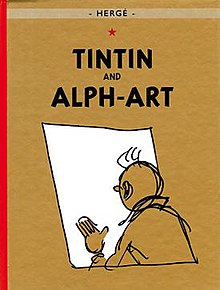Tintin and Alph-Art
|
Tintin and Alph-Art (Tintin et l'alph-art) |
|
|---|---|

Cover of the English-language edition
|
|
| Date | 1986 |
| Series | The Adventures of Tintin |
| Publisher | Casterman |
| Creative team | |
| Creator | Hergé |
| Original publication | |
| Language | French |
| Translation | |
| Publisher | Egmont/Sundancer |
| Date | 1990 |
| Translator |
|
| Chronology | |
| Preceded by | Tintin and the Picaros (1976) |
Tintin and Alph-Art (French: Tintin et l'alph-art) is the unfinished twenty-fourth and final volume of The Adventures of Tintin, the comics series by Belgian cartoonist Hergé. The story revolves around Brussels' modern art scene, where the young reporter Tintin discovers that a local art dealer has been murdered. Investigating further, he encounters a conspiracy of art forgery, masterminded by a religious guru named Endaddine Akass.
Reflecting his own fascination for modern art, Hergé began work on Tintin and Alph-Art in 1978, however it was left unfinished at the time of his death in March 1983. At this point it consisted of around 150 pages of pencil-drawn notes – not yet rendered in Hergé's trademark ligne claire drawing style – with no ending having been devised for the story. Hergé's colleague Bob de Moor offered to complete the story for publication, and while Hergé's widow Fanny Vlamyck initially agreed, she changed her decision, citing the fact that her late husband had not wanted anyone else to continue The Adventures of Tintin. A selection of the original notes were collected together and published in book form by Casterman in 1986. Since that point, a number of other cartoonists, such as Yves Rodier, have produced their own finished, unauthorized versions of the story. Critical reception of the work has been mixed; some commentators on The Adventures of Tintin have believed that Tintin and Alph-Art would have been an improvement over much of Hergé's later work, while others have characterised this as wishful thinking.
Tintin and Captain Haddock receive a phone call from their friend, the opera singer Bianca Castafiore, who informs them about a new spiritual leader whom she has begun following, Endaddine Akass, stating her intention to stay at his villa in Ischia. Later that day, Haddock enters the Fourcart Gallery in Brussels, where Jamaican avant-garde artist Ramó Nash convinces him to purchase one of his "Alph-Art" works, a perspex letter "H". The gallery's owner, Henri Fourcart, arranges to meet Tintin, but is killed in a car accident while on his way to do so. Tintin begins to investigate, discovering that Fourcart's death was murder. Tintin and Haddock attend one of Akass' lectures; there, Tintin recognises Akass' voice, but is unsure why. Investigating further, he concludes that Akass was spying on Fourcart through a micro-transmitter hidden in a pendant worn by the latter's assistant, Martine Vandezande. Tintin soon faces a number of attacks designed to kill him, but survives both.
...
Wikipedia
